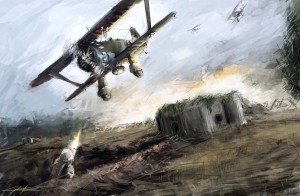 As soon as the Nazis came to power in 1933 an early priority was the re-establishment of an air force. One of the first requirements issued by the new Luftwaffe was for a dive bomber/ground attack aircraft. Henschel Flugzeugwerke A.G. won the contract with a design for an all-metal biplane. Very solidly built and capable of operating from primitive airfields, the Hs 129 was equipped with a BMW 132Dc 9-cylinder air-cooled engine that attained a top speed of 211 mph at 3,935 feet. Armament was two 7.92 mm MG 17 machine guns in the nose firing through the two-bladed metal propeller. The Hs 129 could carry one SC250 548-pound bomb under the fuselage and four SC50 110-pound bombs under the wings. The 880hp engine managed a maximum range of 298 miles with a full bomb load. – Painting by Ondřej Soukup
As soon as the Nazis came to power in 1933 an early priority was the re-establishment of an air force. One of the first requirements issued by the new Luftwaffe was for a dive bomber/ground attack aircraft. Henschel Flugzeugwerke A.G. won the contract with a design for an all-metal biplane. Very solidly built and capable of operating from primitive airfields, the Hs 129 was equipped with a BMW 132Dc 9-cylinder air-cooled engine that attained a top speed of 211 mph at 3,935 feet. Armament was two 7.92 mm MG 17 machine guns in the nose firing through the two-bladed metal propeller. The Hs 129 could carry one SC250 548-pound bomb under the fuselage and four SC50 110-pound bombs under the wings. The 880hp engine managed a maximum range of 298 miles with a full bomb load. – Painting by Ondřej Soukup
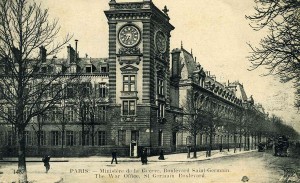 The modern Ministry of War in Paris was completed in 1877 and occupies a large parcel of land bordered by the Boulevard St. Germain, Rue St. Dominique, Rue de Bourgogne and the Rue de l’Université in the city’s 7th arrondissement. The building is on the south side of the Seine River and has more than 1,000 rooms. Underneath the clock tower was an archive that originally held 40,000 volumes. The Ministère de la Guerre is very close to the legislative assembly of the French Parliament, la Chambre des députés (Chamber of Deputies).
The modern Ministry of War in Paris was completed in 1877 and occupies a large parcel of land bordered by the Boulevard St. Germain, Rue St. Dominique, Rue de Bourgogne and the Rue de l’Université in the city’s 7th arrondissement. The building is on the south side of the Seine River and has more than 1,000 rooms. Underneath the clock tower was an archive that originally held 40,000 volumes. The Ministère de la Guerre is very close to the legislative assembly of the French Parliament, la Chambre des députés (Chamber of Deputies).
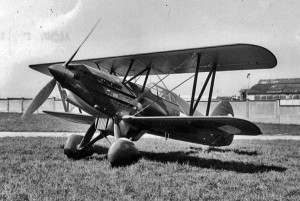 The most advanced fighter in Czechoslovak service during 1938 was the Avia B-534. The aircraft was first taken on by squadrons in the latter half of 1935. The fourth and final production series had an enclosed cockpit, which made it the fastest version. Of the 370 B-534s available in October of 1938, 271 were Series IV. The fighter was equipped with an Hispano-Suiza 12Ydrs liquid-cooled 12-cylinder engine. The B-534 had a top speed of 252 mph at 14,760 feet. Armament was four 7.92mm vz.30 machine guns in the fuselage firing through the Letov Hd-43 two-bladed metal propeller. With a 70-gallon fuel tank capacity, the 850hp engine managed a maximum range of 373 miles.
The most advanced fighter in Czechoslovak service during 1938 was the Avia B-534. The aircraft was first taken on by squadrons in the latter half of 1935. The fourth and final production series had an enclosed cockpit, which made it the fastest version. Of the 370 B-534s available in October of 1938, 271 were Series IV. The fighter was equipped with an Hispano-Suiza 12Ydrs liquid-cooled 12-cylinder engine. The B-534 had a top speed of 252 mph at 14,760 feet. Armament was four 7.92mm vz.30 machine guns in the fuselage firing through the Letov Hd-43 two-bladed metal propeller. With a 70-gallon fuel tank capacity, the 850hp engine managed a maximum range of 373 miles.
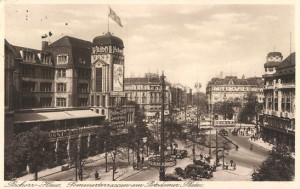 The Pschorr-Haus was one of the large beer palaces in the center of Berlin located near the city’s busiest train station, the Potsdamer Bahnhof. The establishment was opened originally in 1910 as the Bierhaus Siechen – a brewery restaurant with multiple beer halls, dining rooms and banquet halls. Situated in the Potsdamer Platz amidst the nightclubs, cinemas and cafes at the center of the capital’s nightlife during the first half of the 20th Century, the Pschorr-Haus was also close to the Brandenburg Gate, government ministries, plus ample rail and bus public transportation.
The Pschorr-Haus was one of the large beer palaces in the center of Berlin located near the city’s busiest train station, the Potsdamer Bahnhof. The establishment was opened originally in 1910 as the Bierhaus Siechen – a brewery restaurant with multiple beer halls, dining rooms and banquet halls. Situated in the Potsdamer Platz amidst the nightclubs, cinemas and cafes at the center of the capital’s nightlife during the first half of the 20th Century, the Pschorr-Haus was also close to the Brandenburg Gate, government ministries, plus ample rail and bus public transportation.
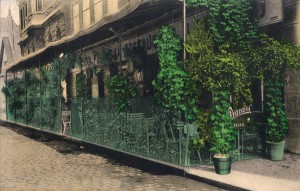 Close to Wenceslas Square, U Pinkasů was the first pub in Prague to serve Pilsner Urquell in 1843. The establishment soon became so popular that an adjoining property was purchased in 1876 so the tavern could be expanded. During the latter half of the 19th Century, U Pinkasů also became one of the favored meeting places for leaders of the Czechoslovak independence movement. Taking up three floors, the basement level and first floor are traditional pubs, with the top floor operating more as a restaurant.
Close to Wenceslas Square, U Pinkasů was the first pub in Prague to serve Pilsner Urquell in 1843. The establishment soon became so popular that an adjoining property was purchased in 1876 so the tavern could be expanded. During the latter half of the 19th Century, U Pinkasů also became one of the favored meeting places for leaders of the Czechoslovak independence movement. Taking up three floors, the basement level and first floor are traditional pubs, with the top floor operating more as a restaurant.
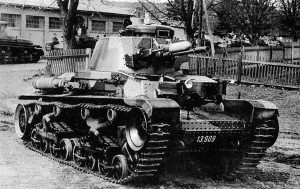 During 1934 the Czechoslovak Ministry of National Defense issued a requirement for a new class of cavalry tanks. Both Praga and Škoda entered the competition and produced prototypes that were available the next year. Škoda won the contract and its design went into production as the LT vz. 35 – sometimes shortened to LT-35. The light tank had 25mm armor and was one of the most advanced and powerful armored vehicles when it went into service late in 1936. By 1938, 298 had been delivered. The main gun was a 37mm Škoda vz. 34 cannon, augmented by two 7.92 Zbrojovka Brno TK vz. 37 machine guns. The Škoda T-11/0 four-cylinder, water-cooled engine moved the 10.5-ton tank to a maximum of 25 miles an hour. The LT vz. 35 had a three-man crew.
During 1934 the Czechoslovak Ministry of National Defense issued a requirement for a new class of cavalry tanks. Both Praga and Škoda entered the competition and produced prototypes that were available the next year. Škoda won the contract and its design went into production as the LT vz. 35 – sometimes shortened to LT-35. The light tank had 25mm armor and was one of the most advanced and powerful armored vehicles when it went into service late in 1936. By 1938, 298 had been delivered. The main gun was a 37mm Škoda vz. 34 cannon, augmented by two 7.92 Zbrojovka Brno TK vz. 37 machine guns. The Škoda T-11/0 four-cylinder, water-cooled engine moved the 10.5-ton tank to a maximum of 25 miles an hour. The LT vz. 35 had a three-man crew.
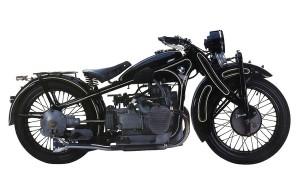 The motorcycle that U.S. military attaché Nathaniel Bulloch uses to swiftly get around to observe different hot spots during the Sudeten Crisis is a 1931 Series 2 BMW R11. The R11 had an extremely strong twin loop pressed steel frame that could handle extra weight and stress. The M56 four-stroke, two-cylinder, flat twin, 745 cc engine was rated at 18 hp at 3,400 rpm. Top speed was 62 mph, with mileage around 55 mpg.
The motorcycle that U.S. military attaché Nathaniel Bulloch uses to swiftly get around to observe different hot spots during the Sudeten Crisis is a 1931 Series 2 BMW R11. The R11 had an extremely strong twin loop pressed steel frame that could handle extra weight and stress. The M56 four-stroke, two-cylinder, flat twin, 745 cc engine was rated at 18 hp at 3,400 rpm. Top speed was 62 mph, with mileage around 55 mpg.
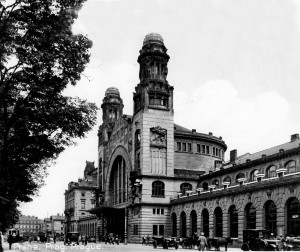 The main rail station in Prague was constructed in 1871 under Austrian rule as Franz Josef Station. That Neo-Renaissance building lacked capacity and was replaced by a new Art Nouveau structure that was built between 1901 and 1909, one of the largest in the world in that style at the time. The main entrance hall was constructed in the shape of a horseshoe dominated by two prominent towers, each topped by glass domes. The interior featured ornate statues and murals under a considerable dome. After the First Czechoslovak Republic was declared in 1918 the station was renamed Wilsonovo nádraží in honor of U.S. President Woodrow Wilson. During 1922 the Czech Astronomical Society set up shop in one of the towers but soon found smoke from the locomotives made their work difficult and they soon sought other accommodations.
The main rail station in Prague was constructed in 1871 under Austrian rule as Franz Josef Station. That Neo-Renaissance building lacked capacity and was replaced by a new Art Nouveau structure that was built between 1901 and 1909, one of the largest in the world in that style at the time. The main entrance hall was constructed in the shape of a horseshoe dominated by two prominent towers, each topped by glass domes. The interior featured ornate statues and murals under a considerable dome. After the First Czechoslovak Republic was declared in 1918 the station was renamed Wilsonovo nádraží in honor of U.S. President Woodrow Wilson. During 1922 the Czech Astronomical Society set up shop in one of the towers but soon found smoke from the locomotives made their work difficult and they soon sought other accommodations.
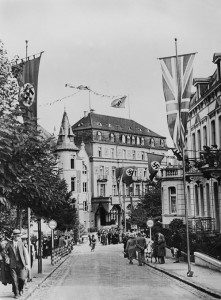 When British prime minister Neville Chamberlain flew to Germany on September 22nd, 1938 for a summit with German chancellor Adolph Hitler in Bad-Godesberg on the Rhine near Bonn it was Chamberlain’s second meeting with Hitler in as many weeks. The British leader was desperate to find any solution to forestall an armed conflict between Czechoslovakia and Germany that would drag the United Kingdom into the hostilities, regardless of what hardships might be imposed on the Czechoslovaks. The Germans spared no expense in making the British delegation feel welcome. On every street in the city, Union Jacks and the Nazi Swastika flew side by side.
When British prime minister Neville Chamberlain flew to Germany on September 22nd, 1938 for a summit with German chancellor Adolph Hitler in Bad-Godesberg on the Rhine near Bonn it was Chamberlain’s second meeting with Hitler in as many weeks. The British leader was desperate to find any solution to forestall an armed conflict between Czechoslovakia and Germany that would drag the United Kingdom into the hostilities, regardless of what hardships might be imposed on the Czechoslovaks. The Germans spared no expense in making the British delegation feel welcome. On every street in the city, Union Jacks and the Nazi Swastika flew side by side.
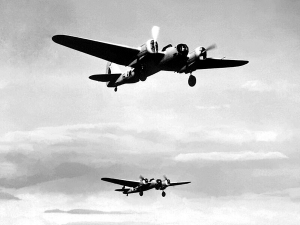 The fast and sleek Tupolev SB-2 light bomber had already drawn blood in Spanish skies when Czechoslovakia came to terms with the Soviet Union in 1937 to purchase 60 examples of the aircraft direct from the manufacturer, and secured a license to produce more. Under the terms of the deal, the planes were delivered with Avia-built Hispano-Suiza 12-Ydrs liquid-cooled 12-cylinder engines turning Letov Hd-43 two-bladed metal propellers. For defense, Czech 7.92mm vz.30 machine guns replaced the Soviet 7.62mm ShKAS originals. Six 220-pound bombs could be carried. In Czechoslovak service the bomber was designated B-71 and had a maximum speed of 267 mph. With a 423-gallon fuel tank capacity, the 850hp engine managed a maximum range of 621 miles.
The fast and sleek Tupolev SB-2 light bomber had already drawn blood in Spanish skies when Czechoslovakia came to terms with the Soviet Union in 1937 to purchase 60 examples of the aircraft direct from the manufacturer, and secured a license to produce more. Under the terms of the deal, the planes were delivered with Avia-built Hispano-Suiza 12-Ydrs liquid-cooled 12-cylinder engines turning Letov Hd-43 two-bladed metal propellers. For defense, Czech 7.92mm vz.30 machine guns replaced the Soviet 7.62mm ShKAS originals. Six 220-pound bombs could be carried. In Czechoslovak service the bomber was designated B-71 and had a maximum speed of 267 mph. With a 423-gallon fuel tank capacity, the 850hp engine managed a maximum range of 621 miles.
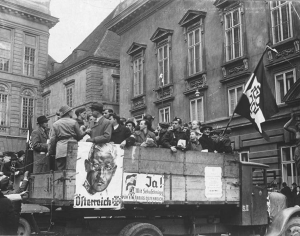 Through most of the 1930s Austria was governed by an autocratic dictatorship that attempted to navigate a middle course that would prevent the national socialists and social democrats from pulling the country into civil war. Adolph Hitler upset that balance when he ordered Austrian Nazis to orchestrate a putsch to take power and join Austria with Germany. Kurt von Schuschnigg was Austrian chancellor and leader of the Fatherland Front party. As street riots escalated, Schuschnigg called out his own supporters to push back against the Nazis.
Through most of the 1930s Austria was governed by an autocratic dictatorship that attempted to navigate a middle course that would prevent the national socialists and social democrats from pulling the country into civil war. Adolph Hitler upset that balance when he ordered Austrian Nazis to orchestrate a putsch to take power and join Austria with Germany. Kurt von Schuschnigg was Austrian chancellor and leader of the Fatherland Front party. As street riots escalated, Schuschnigg called out his own supporters to push back against the Nazis.
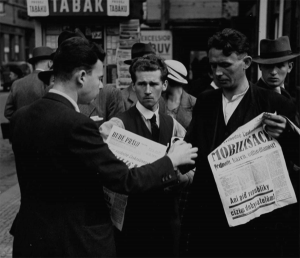 When Adolph Hitler’s demands at the Godesberg summit went further than Great Britain and France could stomach, the governments of both countries formally advised Czechoslovak president Edvard Beneš that they could no longer argue against fully mobilizing the army in defense against Germany. On September 24, 1938 the order calling up reservists was met with great enthusiasm by the public. In all, 1,250,000 men joined their regiments within 48 hours.
When Adolph Hitler’s demands at the Godesberg summit went further than Great Britain and France could stomach, the governments of both countries formally advised Czechoslovak president Edvard Beneš that they could no longer argue against fully mobilizing the army in defense against Germany. On September 24, 1938 the order calling up reservists was met with great enthusiasm by the public. In all, 1,250,000 men joined their regiments within 48 hours.
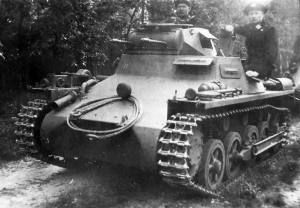 At the time of the Sudeten Crisis the vast majority of tanks in German service, more than 1,000, were the lightly armed PzKpfw I. The vehicle was originally designed as a training tank with extremely light armor of between 7mm and 13 mm thickness, and only two 7.92mm Maschinengewehr 13 machine guns as armament. The PzKpfw I entered Wehrmacht service in 1934 and took part in all major campaigns through the invasion of the Soviet Union in 1941. The four-cylinder Krupp M 305 air-cooled engine moved the 5.4 ton tank to a maximum speed of 23 miles an hour. The PzKpfw I had a two-man crew.
At the time of the Sudeten Crisis the vast majority of tanks in German service, more than 1,000, were the lightly armed PzKpfw I. The vehicle was originally designed as a training tank with extremely light armor of between 7mm and 13 mm thickness, and only two 7.92mm Maschinengewehr 13 machine guns as armament. The PzKpfw I entered Wehrmacht service in 1934 and took part in all major campaigns through the invasion of the Soviet Union in 1941. The four-cylinder Krupp M 305 air-cooled engine moved the 5.4 ton tank to a maximum speed of 23 miles an hour. The PzKpfw I had a two-man crew.
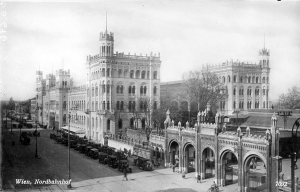 Completed during 1865 the north rail station in 2nd district of Vienna was one of the major train stations in Europe. Like many other civic structures constructed during the 19th Century in Austria-Hungary, the emphasis was on luxury. The exterior of the station was built in the Moorish style with a spacious entrance hall and an interior decorated with ornate frescoes and sculptures.
Completed during 1865 the north rail station in 2nd district of Vienna was one of the major train stations in Europe. Like many other civic structures constructed during the 19th Century in Austria-Hungary, the emphasis was on luxury. The exterior of the station was built in the Moorish style with a spacious entrance hall and an interior decorated with ornate frescoes and sculptures.
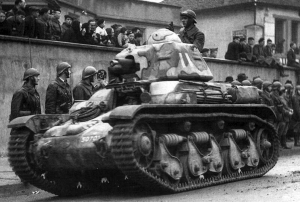 The Char léger Modèle 1935 R was the most numerous tank in French service during 1938 at more than 1,200. The R35 was a light infantry support tank intended to battle opposing troops and machine gun nests. It was therefore equipped with a short semi-automatic 37mm SA18 L/21 cannon dating to the first World War that was ill-suited to piercing armor plate. As an infantry tank the top speed was intentionally slow at 12 mph to 14 mph. As with most French tanks, the R35 used the inefficient one man APX turret, as well as employing thick cast armor. The plate was between 40mm and 43mm except for the rear of the vehicle, which was 32mm. The R35 also was equipped with one 7.5mm Mitrailleuse mld 1931 machine gun. The engine was an 85hp Renault V-4. The R35 had a two-man crew.
The Char léger Modèle 1935 R was the most numerous tank in French service during 1938 at more than 1,200. The R35 was a light infantry support tank intended to battle opposing troops and machine gun nests. It was therefore equipped with a short semi-automatic 37mm SA18 L/21 cannon dating to the first World War that was ill-suited to piercing armor plate. As an infantry tank the top speed was intentionally slow at 12 mph to 14 mph. As with most French tanks, the R35 used the inefficient one man APX turret, as well as employing thick cast armor. The plate was between 40mm and 43mm except for the rear of the vehicle, which was 32mm. The R35 also was equipped with one 7.5mm Mitrailleuse mld 1931 machine gun. The engine was an 85hp Renault V-4. The R35 had a two-man crew.
